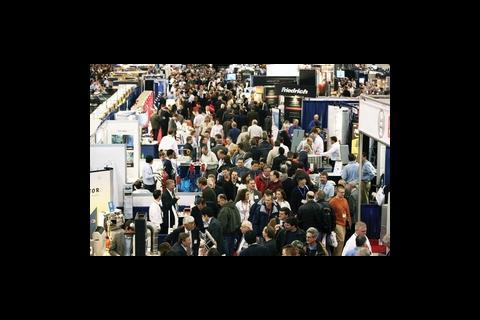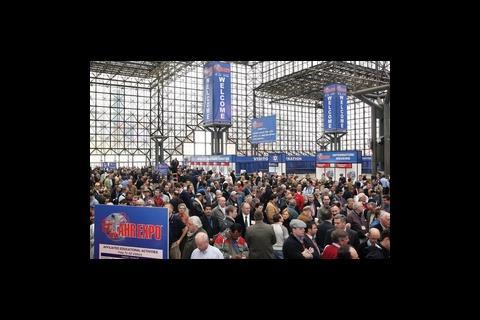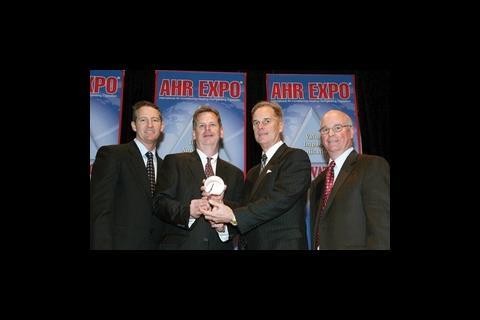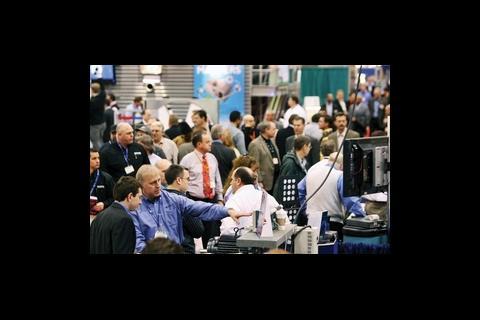There were lessons from across the pond at ASHRAE’s winter gathering, with big interest in CIBSE’s natural ventilation guide. Tim Dwyer reports on the growing US appetite for sustainability
The American Society of Heating, Refrigerating and Air-conditioning Engineers returned to its roots when the winter meeting was held in New York, where the organisation originally had its home. More than 2500 delegates attended the meeting, held in January just a couple of blocks south of Central Park. It commenced at the plenary session, staged in front of a glorious painted tableau of New York landmarks, with CEO Jeff Littleton reporting a year of continued focus on sustainability coupled with exceptional financial performance.
Kent Peterson, now well into his presidential year, spoke with ease and authority to the capacity crowd, commending the work of the society’s volunteers and reiterating his confidence that ASHRAE members can engineer sustainable solutions to improve the environment.
The plenary is used to honour the good and the great of ASHRAE and, at this meeting, the posthumous Hall of Fame award went to Ole Fanger. An amusing and touching eulogy was presented by Fanger’s protege, Bjarne Olesen, now ASHRAE director at large. As well as celebrating Fanger’s huge contribution to the understanding of human comfort, Olesen revealed his love of fine cigars in the years preceding his work on air quality.
A feature of the opening plenary in recent years has been an inspirational speaker. Previous years have seen a round-the-world balloonist and a long-distance swimmer. This year it was comedian Steve Rizzo, who now bills himself as “the attitude adjuster”. He promised to show delegates “how to promote peak performance” but appeared to have missed the mark, with many delegates saying afterwards that they were indifferent to his truistic message that good humour and personal choice make for a happy life.
There was much greater enthusiasm for the news that ASHRAE has made the Advanced Energy Design Guide series freely downloadable from http://www.ashrae.org/freeaedg. The guides, aimed at contractors and designers, provide practical guidance to achieve a 30% energy saving compared with buildings that meet the minimum requirements of ASHRAE Standard 90.1-1999, Energy Standard for Buildings Except Low-Rise Residential Buildings. The guides include the newly released Advanced Energy Design Guide for K-12 School Buildings.
The new 2007 version of Standard 90.1 was released at the meeting, in line with the three-year regular development cycle. It included 47 addenda to the 2004 version, aimed at further reducing energy use. Big changes include more stringent control on demand ventilation, higher boiler efficiencies, fan power limitations and lower U-values and higher performance fenestration – all in all providing about a 10% saving over the 2004 version.
There was much talk about the new ASHRAE Standard 189.1, providing minimum sustainability requirements for the design of high-performance new commercial buildings and large renovation projects, which is under development. Standard 189.1 is targeted at a 30% improvement over Standard 90.1-2007 (in line with the US Energy Policy Act 2005 for government buildings) and addresses the same five main topic areas as the LEED rating system – sustainable site development, water savings, energy efficiency, the effect of materials selection on the atmosphere and natural resources, and indoor environmental quality. The code incorporates a CO2 equivalency alternative compliance method, a method not unfamiliar for those working with Part L of the UK Building Regulations.
The 1850 stands at the AHR Expo which accompanied the meeting, held at the nearby Javits Center, also had an emphasis on energy-efficiency. The US Department of Energy sponsored a zero-energy buildings exhibit that showcased research into systems integration of residential and commercial buildings with renewable and other on-site power systems. Practical examples showing cost trade-offs between investments in energy efficiency and on-site power systems were made available, firmly aimed at the practitioner rather than the academic.
ASHRAE ran technical sessions and courses at the exhibition. The interest in alternative systems was confirmed by the sell-out short course given by UK engineer Frank Mills, of Environmental Design Consultants, based on CIBSE’s natural ventilation guide, AM10. This attracted an unprecedented 61 delegates.
A round-table discussion entitled Lessons Learned in Sustainable Design, which provided candid experiences of real-world design and operation of some of New York’s high-profile “green” towers, drew a disappointingly small audience. This involved two of the city’s owner/ developer firms, Don Winston of the Durst Organization and Tom Scarola of Tishman Speyer, with the engineering designers Scott Frank of JBB and Dan Nall of Flack + Kurtz. They were responsible for new landmarks such as the 54-storey Bank of America Tower and the 48-storey building at 4 Times Square. The speakers reported that tenants of new towers demanded greener solutions, but a well-motivated owner/client was required to have the determination to meet this demand.
They emphasised that to achieve a successful development, the engineering designers needed to be included at the inception of the project, and the commissioning engineers had to be involved fully to bring the building into operation successfully. Nall commented that it must be a “…multi-disciplinary design process where the whole team considers factors including marketability, flexibility and exit strategy – throughout the design, construction and operation there needs to be continued verification that goals are achieved”.
Part of the challenge was that tenants frequently over-specified their power needs, often demanding that installed capacity should be able to meet peak demands of anything between 120 and 195W/m2, although Winston’s metered use had shown less than 40W/m2 and he would expect a new building to work at less than 30W/m2.
ASHRAE has just announced that it is to develop a Building Energy Labelling Program, and is to draw on CIBSE’s experience. Scott Frank’s said that fan and pump efficiency had not been considered seriously and, increasingly, proper evaluation and design of these could provide significant improvements in operation. Surprisingly, as Nall observed, variable frequency drives for fans and pumps are not common in heating, ventilation, air-conditioning and refrigeration applications in the USA.
Scarola tackled the thorny issue of what it costs to go green. As a developer, he acknowledged that it does cost including substantial soft costs of modelling and developing specifications (site selection, communication/transport plans, materials, etc).
He noted that on any medium-to-large commercial development, $75,000-$100,000 was required to model the building. To move a building from simply being code compliant to meeting the requirements of the LEED 2 green building accreditation added 2% to costs, he said, adding that the “payback” period for building green in New York City was five to six years.
In a separate technical session, Green Building Energy Performance: Some Experience and Data From the Field, Winston provided direct feedback from 4 Times Square, known as the Conde Nast Building. His experiences with phosphoric acid fuel cells had led him to believe that they were currently not viable, because they were so maintenance-intensive that break-even was unachievable and because the space they required made them unsuitable for city centre office buildings.
All participants in the round-table discussions reiterated the point that the most successful projects were those where the clients were properly informed and the engineers were involved at the conceptual stage. A truly collaborative process was needed: in Frank’s words, “try to put behind you what was done for the last 20 jobs harvest the strength of the team for a consensus decision”.
Source
Building Sustainable Design
Postscript
Original print headline: "Green Apple" (Building Services Journal, March 2008)




























No comments yet